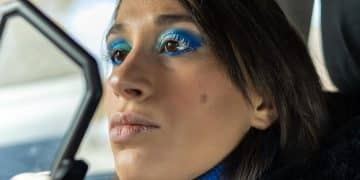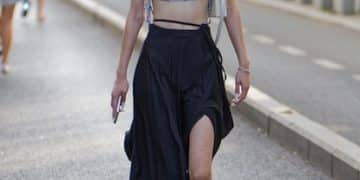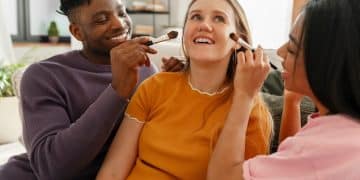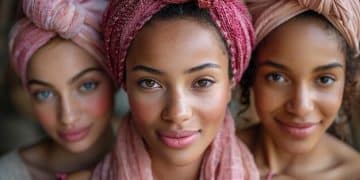The Power of Color: Mastering Theory for Stunning Outfits
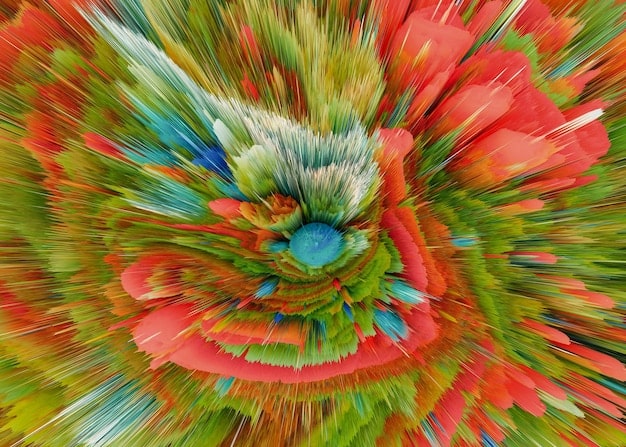
Anúncios
The power of color lies in its ability to transform an outfit, reflecting mood and personal style through the strategic application of color theory principles like complementary and analogous schemes, enhancing visual appeal and confidence.
Ever wondered why some outfits just pop, while others fall flat? The secret often lies in the strategic use of color. Understanding the power of color: discover how to use color theory to create stunning outfits isn’t just about picking shades you like; it’s about mastering a language that communicates mood, style, and confidence.
The Foundations of Color Theory in Fashion
Color is more than just a visual stimulus; it’s a powerful psychological tool that influences perception and emotion. In the realm of fashion, applying the basic principles of color theory can elevate an outfit from ordinary to extraordinary, guiding choices that resonate with personal expression and visual harmony.
Before diving into specific combinations, it’s essential to grasp the fundamental concepts that underpin color theory. This understanding provides a framework for making deliberate and effective choices, moving beyond mere guesswork to informed artistry in dressing.
Understanding the Color Wheel
The color wheel is the cornerstone of color theory, illustrating relationships between colors. It typically organizes colors into primary, secondary, and tertiary categories, offering a visual roadmap for creating harmonious palettes.
- Primary Colors: Red, blue, and yellow. These are the foundational colors from which all other colors are derived. They cannot be created by mixing other colors.
- Secondary Colors: Orange, green, and violet. Formed by mixing two primary colors. For example, red and yellow make orange.
- Tertiary Colors: Red-orange, yellow-orange, yellow-green, blue-green, blue-violet, and red-violet. Created by mixing a primary color with a secondary color.
Warm and Cool Tones
Colors are also categorized as warm or cool, each evoking distinct feelings and suiting different complexions. Warm colors like reds, oranges, and yellows tend to be energetic and inviting, while cool colors such as blues, greens, and purples often feel calm and serene. Knowing your undertones – warm, cool, or neutral – can immensely help in selecting colors that flatter your skin, hair, and eyes, making your outfits look truly stunning.
The dichotomy of warm versus cool extends beyond personal palette; it influences the overall mood and impression of an outfit. A vibrant red dress conveys a very different message than a soothing navy blue one, even if both are equally well-fitted.
In essence, mastering these foundational elements isn’t about rigid rules, but about building an intuitive understanding that allows for creative, intentional dressing. The more familiar you become with these basics, the more confidently you can experiment and develop a distinctive personal style.
Harmonious Color Schemes and Their Impact
Once the basics of the color wheel are clear, the next step involves exploring how colors combine to create visually appealing and harmonious schemes. These schemes are not arbitrary; they are derived from mathematical relationships on the color wheel and serve as powerful tools for crafting cohesive and impactful outfits.
Complementary Colors: The Bold Contrast
Complementary colors are those located directly opposite each other on the color wheel, such as red and green, blue and orange, or yellow and purple. They offer the highest contrast, creating a bold and dynamic look that captures attention. When used together, they make each other appear more vibrant and intense.
- Application in Fashion: Often used for statement pieces or to add a pop of color. A royal blue dress with orange accessories, or a deep green blazer paired with a bright red scarf, exemplifies this scheme.
- Moderation is Key: While impactful, using complementary colors in equal measure can be overwhelming. It’s often more effective to let one color dominate and use its complement as an accent. This creates visual interest without jarring the eye.
Analogous Colors: Subtle Sophistication
Analogous colors are groups of three colors that are next to each other on the color wheel, sharing a common hue. Examples include blue, blue-green, and green, or red, red-orange, and orange. This scheme offers a more subtle and sophisticated harmony, creating a cohesive and visually pleasing flow.
Unlike the high contrast of complementary colors, analogous schemes provide a gentle transition between shades, ideal for creating a harmonious and polished look. They are often found in nature and tend to feel comforting and inviting.
In fashion, analogous schemes are perfect for creating monochromatic or tone-on-tone outfits that exude elegance and refinement. Think of various shades of blue in a single outfit, from a navy skirt to a sky-blue top and turquoise jewelry. This approach deepens the visual narrative without relying on stark contrasts, making it a favorite for professional and elegant ensembles.
Triadic Colors: Playful Balance
Triadic color schemes involve three colors that are equidistant on the color wheel, forming a perfect triangle. Primary colors (red, blue, yellow) form a classic triad, as do secondary colors (orange, green, violet). These schemes offer a vibrant and balanced look, often feeling playful and dynamic while maintaining harmony.
Given their inherent balance, triadic schemes are less likely to clash than haphazardly chosen colors. They provide a high degree of contrast while retaining visual order, making them versatile for a range of fashion statements.
When incorporating a triadic scheme, it’s often wise to choose one dominant color and use the other two as accents. For instance, a yellow top could be paired with blue jeans and a subtle red belt, offering a lively yet coherent appearance without overwhelming the senses. Such balanced application prevents the outfit from looking like a children’s puzzle and instead elevates it to a sophisticated, bold statement.
Understanding and applying these harmonious color schemes allows for intentional and impactful outfit creation. Moving beyond random choices, you can meticulously craft looks that not only flatter but also communicate a specific aesthetic or mood, enhancing the overall power of your wardrobe.
Monochromatic Magic and Neutral Foundations
While dynamic color schemes offer exciting possibilities, the power of a single color or a neutral palette should not be underestimated. Monochromatic looks exude sophistication, and neutrals provide the essential canvas upon which all other colors can truly shine. Both approaches are cornerstones in building a versatile and impactful wardrobe.
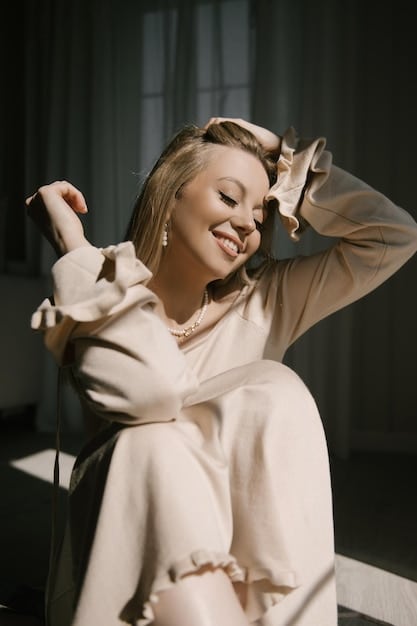
The Elegance of Monochromatic Outfits
A monochromatic outfit doesn’t mean wearing the exact same shade from head to toe. Rather, it involves using different tones, tints, and shades of a single base color. For instance, a light blue shirt, a medium blue pant, and a navy blazer create a monochromatic look that is rich in depth and texture. This approach creates a seamless, elongated silhouette and conveys an air of effortless chic.
- Adding Depth: Varying textures (e.g., silk, wool, denim in the same color family) or fabrics can add immense interest to a monochromatic outfit, preventing it from appearing flat.
- Subtle Pops: While the core is one color, subtle accessories in a complementary or analogous shade can further elevate the look without breaking the cohesive feel. A deep green outfit can be subtly enhanced with a gold necklace, adding a touch of warmth.
Monochromatic dressing is particularly powerful because it simplifies the decision-making process while still allowing for significant style statements. It removes the guesswork of color matching and focuses attention on silhouette, texture, and fit, which are equally vital components of a stunning outfit.
Neutral Colors: The Versatile Backbone of Your Wardrobe
Neutrals – black, white, gray, beige, brown, and navy – are the unsung heroes of any wardrobe. They provide a sophisticated backdrop against which brighter colors can truly pop, and they serve as reliable foundations for virtually any outfit. Their versatility is unmatched, making them essential for both casual and formal wear.
- Foundation for Any Look: Neutrals form the base of most outfits, allowing for flexibility in adding colored accessories, shoes, or outerwear. A classic white shirt and black trousers can be styled endlessly with different scarves or blazers.
- Timeless Appeal: Unlike trendy colors that come and go, neutrals remain perpetually stylish, making them a wise investment for core wardrobe pieces. They exude a sense of timeless elegance and sophistication.
The beauty of neutrals lies in their ability to mix and match effortlessly, simplifying daily dressing while always looking polished. They also serve as an excellent canvas for experimenting with vibrant accessories without fear of clashing, proving that sometimes, the most powerful elements in an outfit are those that blend into the background, amplifying everything else.
Integrating monochromatic approaches and embracing neutrals thoughtfully enhances the overall versatility and sophistication of your wardrobe. These strategies provide a solid framework for creating stunning outfits, whether you prefer understated elegance or a dynamic burst of color.
Seasonal Color Palettes and Personal Factors
The world of fashion often aligns with the rhythm of the seasons, influencing not only fabric choices but also the dominant color trends. Beyond trends, understanding your personal attributes – skin tone, hair color, and eye color – is crucial for selecting colors that truly make you shine. Combining seasonal awareness with personal color analysis leads to outfits that feel both timely and deeply flattering.
Dressing for the Seasons: Beyond Trends
While fashion magazines often dictate seasonal color trends, there’s a more fundamental reason why certain colors feel right in certain times of the year. Nature itself provides the best guide:
- Spring: Mimics blossoming flowers and verdant new growth, leaning towards soft, pastel shades like blush pink, mint green, sky blue, and buttery yellow. These colors evoke freshness and rebirth.
- Summer: Reflects bright sunshine, clear skies, and vibrant flora, favoring bold and saturated hues such as fuchsia, coral, turquoise, and brilliant white. These colors amplify the energetic and joyful spirit of the season.
- Autumn: Mirrors falling leaves and harvest, embracing rich, earthy tones like deep burgundy, burnt orange, olive green, mustard yellow, and warm browns. These colors convey coziness and groundedness.
- Winter: Evokes crisp air, snow, and festive holidays, favoring cool, deep, and jewel tones such as sapphire blue, emerald green, ruby red, stark white, and charcoal gray. These colors suggest elegance and a sense of calm strength.
Dressing according to the season isn’t about blind adherence to trends; it’s about aligning your wardrobe with the prevailing mood and natural palette, ensuring your outfits always feel appropriate and harmonious with their environment.
Undertones and How They Impact Your Wardrobe
Perhaps one of the most impactful personal factors in color selection is your skin’s undertone. Unlike your surface skin tone, which can change with sun exposure, your undertone remains constant. There are three main undertones: warm, cool, and neutral.
Identifying Your Undertone
- Vein Test: Look at the veins on your wrist in natural light. Blue or purple veins often indicate cool undertones. Green veins suggest warm undertones. If you can’t tell if they’re blue or green, you likely have neutral undertones.
- Jewelry Test: If gold jewelry looks more flattering on you, you might have warm undertones. If silver jewelry enhances your complexion more, you likely have cool undertones. If both look good, you’re likely neutral.
Dressing for Your Undertone
Once you know your undertone, selecting colors that complement your natural complexions becomes much easier. For warm undertones, colors with yellow, peach, or golden bases (e.g., olive green, cream, coral, warm reds) will flatter. For cool undertones, colors with blue, pink, or purple bases (e.g., true red, emerald green, royal blue, true white) will enhance your features. Neutral undertones have the flexibility to wear both warm and cool shades, making them extremely versatile.
By thoughtfully considering both seasonal palettes and your unique personal coloring, you move beyond merely choosing “pretty” colors. You begin to curate a wardrobe where every hue contributes to a flattering, authentic, and truly stunning overall appearance, maximizing the power of color in your personal styling.
Color Psychology and Expressing Your Mood
Beyond aesthetics, colors carry profound psychological associations, subtly influencing how we feel and how others perceive us. Understanding the emotional impact of different hues allows for a more intentional and powerful approach to fashion, enabling you to express your mood or project a certain image without uttering a single word.
The Emotional Landscape of Hues
Each color possesses its own unique set of psychological attributes, shaping perceptions and evoking specific feelings. Leveraging this knowledge in your daily dressing can be a subtle yet potent form of non-verbal communication.
- Red: Often associated with passion, energy, strength, and confidence. Wearing red can make you feel more assertive and draw attention. It’s excellent for making a bold statement. However, too much red can also be perceived as aggressive.
- Blue: Conveys calm, trust, stability, and professionalism. Ideal for interviews or situations where you want to appear reliable and composed. Lighter blues suggest serenity, while darker blues can imply authority.
- Yellow: Linked to happiness, optimism, warmth, and creativity. A bright yellow can lift spirits and project a friendly, approachable demeanor. Use it to add a spark of joy to your outfit.
- Green: Symbolizes nature, growth, harmony, and balance. It can evoke feelings of freshness and tranquility. Darker greens often suggest wealth and ambition, while lighter greens are more calming.
- Purple: Traditionally associated with royalty, luxury, wisdom, and creativity. It can make an outfit feel sophisticated and unique. Lighter purples often feel romantic, while deeper shades convey power.
Matching Colors to Occasion and Intent
The context in which you wear a color is just as important as the color itself. Consider the message you want to send and the environment you’ll be in:
- For a Job Interview: Opt for blues or grays to convey trustworthiness and professionalism. A splash of a muted green or subtle purple could suggest creativity, but discretion is key. Avoid overly bold or distracting colors.
- For a Social Event: This is an opportunity to express your personality. Vibrant reds, playful yellows, or daring combinations of complementary colors can showcase your lively side. The goal is to feel and look good while being approachable.
- For a Calming Day: Soft pastels, perhaps a monochromatic scheme in cool blues or greens, can reinforce feelings of peace and relaxation. This is about dressing for your internal state and comfort.
- For a Creative Endeavor: Embrace more unconventional color pairings – perhaps a split complementary or a tetradic scheme – to fuel and reflect your innovative spirit. Colors that spark joy and originality are key.
By consciously choosing colors not just for their aesthetic appeal but for their psychological resonance, you transform dressing into an act of self-expression and strategic communication. This understanding is vital to truly harness the power of color to create stunning outfits that not only look good but also profoundly feel right.
Accessorizing with Color: The Finishing Touch
Accessories are the unsung heroes of any wardrobe, offering an accessible and versatile way to inject color, elevate an outfit, and express personal style without committing to a full colored garment. They are powerful tools for fine-tuning your look and harnessing the full potential of color theory, often providing that crucial “finishing touch.”
Adding Pops of Color with Accessories
Even the most neutral or monochromatic outfit can be transformed by strategically placed colored accessories. This approach is particularly effective for those who prefer a minimalist base but still want to explore the dynamic range of the color wheel.
- Scarves and Handbags: A vibrant scarf or a brightly colored handbag can serve as the focal point of an otherwise subdued outfit, instantly drawing the eye and adding personality. Think of a classic black dress elevated by a bold red clutch, or a white shirt and jeans made chic with a patterned scarf featuring splashes of blue and yellow.
- Shoes: Colored shoes are a fantastic way to introduce an unexpected pop of color from the ground up. A pair of emerald green heels with a navy power suit, or bright yellow sneakers with a casual denim outfit, injects playfulness and modernity.
- Jewelry and Belts: Statement necklaces, earrings with colorful stones, or a belt in a contrasting hue can tie an entire look together, or provide that singular burst of color needed to complete the ensemble. A simple white tee and jeans can appear instantly more deliberate with a wide belt in a striking orange or turquoise.
Harmonizing and Contrasting with Accessories
Accessories aren’t just for adding color; they’re also for creating harmony or intentional contrast within your outfit, leveraging the same color theory principles used for main garments.
- Echoing Colors: Use accessories to echo a subtle color present in a print or pattern on your clothing. If your dress has a faint blue stripe, a blue necklace or bracelet can subtly pull that color forward and create a cohesive look. This technique highlights detail and thoughtfulness.
- Complementary Accents: If your outfit is primarily in one color, use an accessory in its complementary shade to create a deliberate and eye-catching contrast. A forest green sweater paired with a chunky red bead necklace makes a bold yet balanced statement. This shows a sophisticated understanding of color relationships.
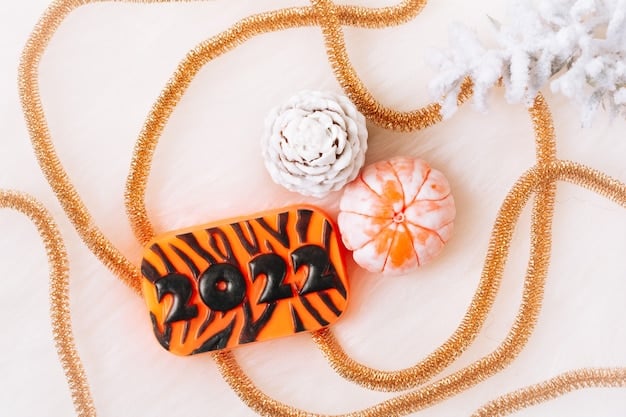
Moreover, accessories offer a low-stakes way to experiment with colors you might otherwise shy away from. Not ready for a full yellow skirt? Try a small yellow clutch or a pair of sunny earrings. This experimentation builds confidence and expand your sartorial boundaries without major wardrobe investments. The thoughtful use of accessories ensures that your outfit is not merely assembled, but artfully curated, demonstrating a true mastery of color’s transformative power.
Ultimately, accessories are crucial for refining any outfit. From subtle harmonization to bold, statement-making contrasts, they hold the power to complete your vision and truly allow the art of color theory to shine through, transforming great outfits into stunning ones.
Building Your Confident Color Wardrobe
Transitioning from understanding color theory to confidently applying it in your everyday wardrobe requires practice, experimentation, and a willingness to step outside your comfort zone. The goal isn’t to follow rigid rules but to develop an intuitive understanding that empowers your personal style and enhances your confidence.
Starting Small and Expanding Your Palette
For many, the idea of incorporating more color feels daunting, especially if a wardrobe is heavily reliant on neutrals. The key is to start small and gradually expand your comfort zone.
- Integrate Small Pops: Begin by introducing single colorful items into otherwise neutral outfits. A vibrant pair of socks, a bright belt, or a patterned tie can be an easy entry point. These small touches allow you to gauge comfort levels and see how colors interact without overwhelming your existing style.
- Experiment with Analogous Schemes: These are generally easier to wear than high-contrast complementary colors, as they offer a gentle transition between hues. Try pairing different shades of a single color you already like, such as various blues or greens. This builds confidence in creating cohesive multi-toned looks.
- Invest in Key Pieces: Once comfortable, consider investing in a statement piece in a color you love and find flattering – perhaps a bold blazer, a colorful pair of trousers, or a striking dress. Build outfits around this piece, allowing it to be the focal point.
Developing Your Signature Color Language
True mastery of color in fashion isn’t about perfectly replicating textbook schemes; it’s about developing a personal color language that reflects who you are and how you want to be perceived. This signature style evolves through conscious choices and self-awareness.
- Pay Attention to Feedback: Notice which colors consistently earn you compliments, or which ones make you feel particularly good and confident. Your body and intuition often know best what truly suits you.
- Curate a Core Palette: Identify a few colors that you consistently gravitate towards and that genuinely flatter your skin tone and personality. These will form the foundation of your “confident color wardrobe,” making dressing a more streamlined and joyful experience.
- Embrace Your Intuition: While theory provides guidance, don’t be afraid to trust your gut. Sometimes, a combination just ‘feels’ right, even if it doesn’t strictly adhere to a formal scheme. Fashion is an art form, and personal expression often transcends rigid rules.
Ultimately, building a confident color wardrobe is a continuous journey of discovery. By understanding the principles of color theory, experimenting thoughtfully, and listening to your own preferences, you empower yourself to create stunning outfits that not only look good but also genuinely reflect your unique identity, truly harnessing the transformative power of color.
| Key Aspect | Brief Description |
|---|---|
| 🎨 Color Wheel Basics | Understand primary, secondary, and tertiary colors as your foundation. |
| 🌈 Harmonious Schemes | Utilize complementary, analogous, and triadic schemes for visual appeal. |
| ✨ Monochromatic & Neutrals | Master single-color depth and the versatility of neutral foundations. |
| moods>💬 Color Psychology | Express mood and convey messages through the emotional associations of colors. |
Frequently Asked Questions About Color Theory in Fashion
For beginners, focus on the color wheel: primary (red, blue, yellow) and secondary (orange, green, purple) colors. Understanding warm versus cool tones is also crucial, as certain shades complement different skin undertones. Start by observing which colors naturally make you feel good and receive compliments, as this often indicates harmonious palette choices.
To use complementary colors effectively without clashing, employ them sparingly or as accents. For instance, pair a dominant color with a small pop of its complement through accessories like a belt, shoes, or a bag. Alternatively, use a muted version of one color alongside a vibrant version of its complement to soften the contrast and create a sophisticated balance.
While not strictly necessary, dressing according to your skin’s undertone (warm, cool, or neutral) can significantly enhance your appearance. Colors that harmonize with your undertone can make your skin look more radiant, your eyes brighter, and your features more defined, adding to the overall “stunning” effect of your outfit. It’s a powerful tool for personal flattery.
Absolutely, mixing warm and cool colors can create dynamic and sophisticated outfits. The key is balance. You might use a cool base like navy and add a warm accent like a mustard yellow scarf, or vice-versa. Think about using a neutral color as a bridge between the warm and cool elements to make the transition smoother and more harmonious, avoiding visual discord.
Seasons naturally guide color choices. Spring leans towards soft pastels, summer to bright, vibrant hues, autumn to earthy and rich tones, and winter to cool, deep jewel tones. Aligning your wardrobe with seasonal palettes creates outfits that feel appropriate and visually cohesive with the natural environment, enhancing the overall aesthetic and impact of your style.
Conclusion
Mastering color theory in fashion is more than just learning about hues and their combinations; it’s about unlocking a powerful tool for self-expression, confidence, and visual communication. By understanding fundamental principles like the color wheel, harmonious schemes, and the psychological impact of colors, you gain the ability to meticulously craft outfits that not only look stunning but also resonate with your personal style and the mood you wish to convey. From bold complementary contrasts to the subtle elegance of monochromatic looks, and from leveraging accessories to understanding your personal undertones, every element contributes to a more intentional and impactful wardrobe. Embrace the journey of color exploration, and you’ll discover endless possibilities for creating truly memorable and powerful ensembles.
